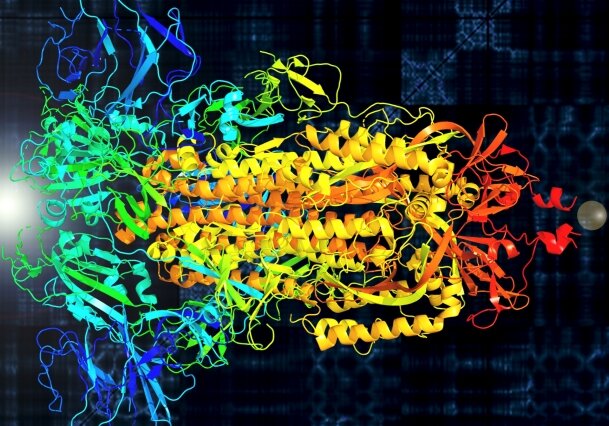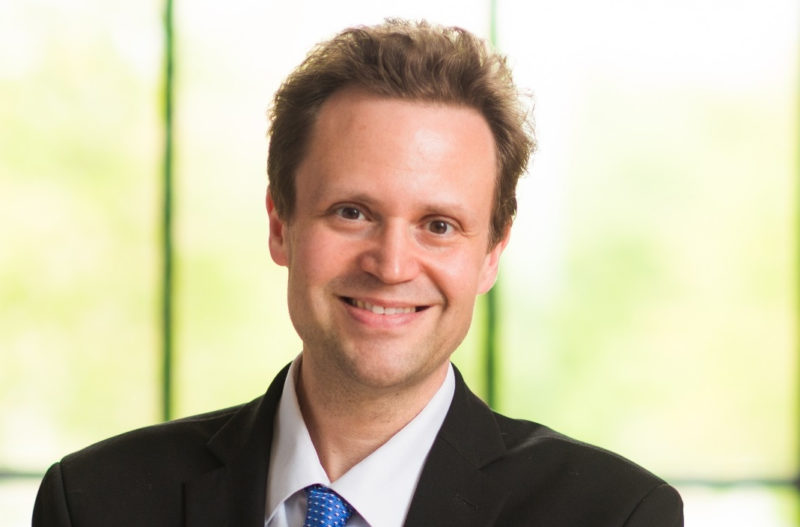
Markus J. Buehler, Ph.D.
AIMBE College of Fellows Class of 2015 For applying computational tools to elucidate complex biomaterials behavior, design new biomaterials, and integrating experiment and simulation across multiple scales
AI system can generate novel proteins that meet structural design targets
Via MIT | April 20, 2023MIT researchers are using artificial intelligence to design new proteins that go beyond those found in nature.
They developed machine-learning algorithms that can generate proteins with specific structural features, which could be used to make materials that have certain mechanical properties, like stiffness or elasticity. Such biologically inspired materials could potentially replace materials made from petroleum or ceramics, but with a much smaller carbon footprint.
The researchers from MIT, the MIT-IBM Watson AI Lab, and Tufts University employed a generative model, which is the same type of machine-learning model architecture used in AI systems like DALL-E 2. But instead of using it to generate realistic images from natural language prompts, like DALL-E 2 does, they adapted the model architecture so it could predict amino acid sequences of proteins that achieve specific structural objectives… Continue reading.
Markus Buehler elected to the National Academy of Engineering for 2023
Via MIT | February 14, 2023Seven MIT researchers are among the 106 new members and 18 international members elected to the National Academy of Engineering (NAE) this week. Fourteen additional MIT alumni, including one member of the MIT Corporation, were also elected as new members.
One of the highest professional distinctions for engineers, membership to the NAE is given to individuals who have made outstanding contributions to “engineering research, practice, or education, including, where appropriate, significant contributions to the engineering literature” and to “the pioneering of new and developing fields of technology, making major advancements in traditional fields of engineering, or developing/implementing innovative approaches to engineering education.” The seven MIT researchers elected this year include:
……
Markus J. Buehler, the Jerry McAfee (1940) Professor in Engineering from the Department of Civil and Environmental Engineering, for implementing the use of nanomechanics to model and design fracture-resistant bioinspired materials… Continue reading.
Can your phone tell if a bridge is in good shape?
Via MIT | November 3, 2022A new study suggests mobile data collected while traveling over bridges could help evaluate their integrity.
Want to know if the Golden Gate Bridge is holding up well? There could be an app for that.
A new study involving MIT researchers shows that mobile phones placed in vehicles, equipped with special software, can collect useful structural integrity data while crossing bridges. In so doing, they could become a less expensive alternative to sets of sensors attached to bridges themselves.
“The core finding is that information about structural health of bridges can be extracted from smartphone-collected accelerometer data,” says Carlo Ratti, director of the MIT Sensable City Laboratory and co-author of a new paper summarizing the study’s findings… Continue reading.
New AI tool calculates materials’ stress and strain based on photos
Via MIT | April 22, 2021Isaac Newton may have met his match.
For centuries, engineers have relied on physical laws — developed by Newton and others — to understand the stresses and strains on the materials they work with. But solving those equations can be a computational slog, especially for complex materials.
MIT researchers have developed a technique to quickly determine certain properties of a material, like stress and strain, based on an image of the material showing its internal structure. The approach could one day eliminate the need for arduous physics-based calculations, instead relying on computer vision and machine learning to generate estimates in real time… Continue reading.
Researcher unraveling SARS-CoV-2 spike protein through music
Via Phys.org | April 10, 2020The proteins that make up all living things are alive with music. Just ask Markus Buehler: The musician and MIT professor develops artificial intelligence models to design new proteins, sometimes by translating them into sound. His goal is to create new biological materials for sustainable, non-toxic applications. In a project with the MIT-IBM Watson AI Lab, Buehler is searching for a protein to extend the shelf-life of perishable food. In a new study in Extreme Mechanics Letters, he and his colleagues offer a promising candidate: a silk protein made by honeybees for use in hive building.

In another recent study, in APL Bioengineering, he went a step further and used AI discover an entirely new protein. As both studies went to print, the Covid-19 outbreak was surging in the United States, and Buehler turned his attention to the spike protein of SARS-CoV-2, the appendage that makes the novel coronavirus so contagious. He and his colleagues are trying to unpack its vibrational properties through molecular-based sound spectra, which could hold one key to stopping the virus. Buehler recently sat down to discuss the art and science of his work… Continue reading.
Amino Acid Rock Music Helps Build New Proteins
Via Scientific American | March 30, 2020The 20 amino acids that make up the building blocks of a protein contain chemical bonds that vibrate at different frequencies. Markus Buehler, a materials scientist and engineer at the Massachusetts Institute of Technology, coded that information, along with the intricate folding patterns of proteins, so that it could be represented as musical properties such as volume, speed and concurrent melodies (known in music theory as counterpoint).
The researchers then took their work a major step further. By feeding the musical interludes generated from known proteins into a neural network, the team trained the artificial intelligence system to develop novel variations of those rhythms—musical representations of proteins that did not yet exist… Continue reading.
Translating proteins into music, and back
Via MIT | June 26, 2019
Want to create a brand new type of protein that might have useful properties? No problem. Just hum a few bars.
In a surprising marriage of science and art, researchers at MIT have developed a system for converting the molecular structures of proteins, the basic building blocks of all living beings, into audible sound that resembles musical passages. Then, reversing the process, they can introduce some variations into the music and convert it back into new proteins never before seen in nature.
Although it’s not quite as simple as humming a new protein into existence, the new system comes close. It provides a systematic way of translating a protein’s sequence of amino acids into a musical sequence, using the physical properties of the molecules to determine the sounds. Although the sounds are transposed in order to bring them within the audible range for humans, the tones and their relationships are based on the actual vibrational frequencies of each amino acid molecule itself, computed using theories from quantum chemistry… Continue reading.
Spider silk could be used as robotic muscle
Via MIT | March 29, 2019Spider silk, already known as one of the strongest materials for its weight, turns out to have another unusual property that might lead to new kinds of artificial muscles or robotic actuators, researchers have found.
The resilient fibers, the team discovered, respond very strongly to changes in humidity. Above a certain level of relative humidity in the air, they suddenly contract and twist, exerting enough force to potentially be competitive with other materials being explored as actuators — devices that move to perform some activity such as controlling a valve.
The findings are being reported today in the journal Science Advances, in a paper by MIT Professor Markus Buehler, head of the Department of Civil and Environmental Engineering, along with former postdoc Anna Tarakanova and undergraduate student Claire Hsu at MIT; Dabiao Liu, an associate professor at Huazhong University of Science and Technology in Wuhan, China; and six others… Continue reading.
Researchers decode molecule that gives living tissues their flexibility
Via MIT | June 25, 2018The stretchiness that allows living tissues to expand, contract, stretch, and bend throughout a lifetime is the result of a protein molecule called tropoelastin. Remarkably, this molecule can be stretched to eight times its length and always returns back to its original size.
Now, for the first time, researchers have decoded the molecular structure of this complex molecule, as well as the details of what can go wrong with its structure in various genetically driven diseases.
Tropoelastin is the precursor molecule of elastin, which along with structures called microfibrils is the key to flexibility of tissues including skin, lungs, and blood vessels. But the molecule is complex, made up of 698 amino acids in sequence and filled with disordered regions, so unravelling its structure has been a major challenge for science… Continue reading.
New nanowires are just a few atoms thick
Via MIT | December 4, 2017“Two-dimensional materials” — materials deposited in layers that are only a few atoms thick — are promising for both high-performance electronics and flexible, transparent electronics that could be layered onto physical surfaces to make computing ubiquitous.
The best-known 2-D material is graphene, which is a form of carbon, but recently researchers have been investigating other 2-D materials, such as molybdenum disulfide, which have their own, distinct advantages.
Producing useful electronics, however, requires integrating multiple 2-D materials in the same plane, which is a tough challenge. In 2015, researchers at King Abdullah University in Saudi Arabia developed a technique for depositing molybdenum disulfide (MoS2) next to tungsten diselenide (WSe2), with a very clean junction between the two materials. With a variation of the technique, researchers at Cornell University then found that they could induce long, straight wires of MoS2 — only a few atoms in diameter— to extend into the WSe2, while preserving the clean junction.
The researchers contacted Markus Buehler, the McAfee Professor of Engineering in MIT’s Department of Civil and Environmental Engineering, who specializes in atomic-level models of crack propagation, to see if his group could help explain this strange phenomenon… Continue reading.
How to build better silk
Via MIT | November 9, 2017When it comes to concocting the complex mix of molecules that makes up fibers of natural silk, nature beats human engineering hands down. Despite efforts to synthesize the material, artificial varieties still cannot match the natural fiber’s strength.
But by starting with silk produced by silkworms, breaking it down chemically, and then reassembling it, engineers have found they can make a material that is more than twice as stiff as its natural counterpart and can be shaped into complex structures such as meshes and lattices.
The new material is dubbed regenerated silk fiber (RSF) and could find a host of applications in commercial and biomedical settings, the researchers say. The findings are reported in the journal Nature Communications, in a paper by McAfee Professor of Engineering Markus Buehler, postdoc Shengjie Ling, research scientist Zhao Qin, and three others at Tufts University… Continue reading.
Markus J. Buehler, Ph.D. To be Inducted into Medical and Biological Engineering Elite
Via AIMBE | March 5, 2015WASHINGTON, D.C.— The American Institute for Medical and Biological Engineering (AIMBE) has announced the pending induction of Markus J. Buehler, Ph.D., Professor & Department Head, Civil and Environmental Engineering, Massachusetts Institute of Technology, to its College of Fellows. Dr. Buehler was nominated, reviewed, and elected by peers and members of the College of Fellows For applying computational tools to elucidate complex biomaterials behavior, design new biomaterials, and integrating experiment and simulation across multiple scales.
 AIMBE
AIMBE
